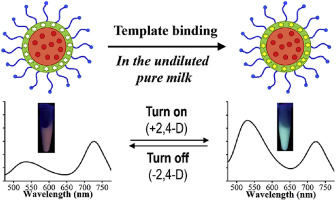Our official English website, www.x-mol.net, welcomes your
feedback! (Note: you will need to create a separate account there.)
Well-defined hydrophilic "turn-on"-type ratiometric fluorescent molecularly imprinted polymer microspheres for direct and highly selective herbicide optosensing in the undiluted pure milks.
Talanta ( IF 5.6 ) Pub Date : 2020-01-03 , DOI: 10.1016/j.talanta.2020.120711 Sijia Xu 1 , Yiwei Zou 1 , Huiqi Zhang 1
Talanta ( IF 5.6 ) Pub Date : 2020-01-03 , DOI: 10.1016/j.talanta.2020.120711 Sijia Xu 1 , Yiwei Zou 1 , Huiqi Zhang 1
Affiliation

|
Molecularly imprinted polymer (MIP)-based optosensing materials capable of direct, reliable, and highly selective detection of small organic analytes in complex aqueous samples hold great promise in many bioanalytical applications, but their development remains a challenging task. Addressing this issue, well-defined hydrophilic "turn-on"-type ratiometric fluorescent MIP microspheres are developed via a versatile and modular strategy based on the controlled/"living" radical polymerization method. Its general principle was demonstrated by the synthesis of red CdTe quantum dot (QD)-labeled silica particles with surface-bound atom transfer radical polymerization (ATRP)-initiating groups via the one-pot sol-gel reaction and their successive grafting of a thin fluorescent 2,4-D (an organic herbicide)-MIP layer (labeled with green organic fluorophores bearing both nitrobenzoxadiazole (NBD) and urea interacting groups) and hydrophilic poly(glyceryl monomethacrylate) (PGMMA) brushes via surface-initiated ATRP. The introduction of PGMMA brushes and rationally selected dual fluorescence labeling (i.e., red CdTe QDs being inert to 2,4-D and green NBD showing fluorescence "light-up" upon binding 2,4-D) onto MIP particles afforded them excellent complex aqueous sample-compatibility (due to their largely enhanced hydrophilicity) and analyte binding-induced "turn-on"-type ratiometric fluorescence changes, respectively. Such advanced MIP particles proved to be promising optosensing materials, which had a detection limit of 0.13 μM and showed obvious fluorescent color change upon binding different concentrations of 2,4-D in the undiluted pure milk. Moreover, they were successfully applied for direct and highly selective quantification of 2,4-D in the undiluted pure goat and bovine milks with good recoveries (97.9%-104.5%), even in the presence of several analogues of 2,4-D.
中文翻译:

定义明确的亲水性“开启”型比率式荧光分子印迹聚合物微球,用于在未稀释的纯牛奶中进行直接和高度选择性的除草剂感光。
基于分子印迹聚合物(MIP)的光敏材料能够直接,可靠和高度选择性地检测复杂水性样品中的小型有机分析物,在许多生物分析应用中都具有广阔的前景,但其开发仍然是一项艰巨的任务。为了解决这个问题,通过基于受控/“活性”自由基聚合方法的通用和模块化策略,开发了定义明确的亲水性“开启”型比例荧光MIP微球。通过一锅溶胶-凝胶反应合成具有表面结合的原子转移自由基聚合(ATRP)引发基团的红色CdTe量子点(QD)标记的二氧化硅颗粒,并通过接枝接枝一种薄层,证明了其一般原理荧光灯2 4-D(有机除草剂)-MIP层(标记有带有硝基苯并恶二唑(NBD)和尿素相互作用基团的绿色有机荧光团)和亲水性聚单甲基丙烯酸甘油酯(PGMMA)刷,通过表面引发的ATRP。PGMMA刷的引入和合理选择的双重荧光标记(即,对2,4-D呈惰性的红色CdTe QD和在结合2,4-D时显示荧光“亮起”的绿色NBD)为它们提供了出色的复合物水性样品的相容性(由于亲水性大大提高)和分析物结合诱导的“开启”型比例荧光变化。这种先进的MIP粒子被证明是很有前途的光敏材料,其检测极限为0。13μM,并在未稀释的纯牛奶中结合不同浓度的2,4-D后显示出明显的荧光颜色变化。此外,即使存在多种2,4-D类似物,它们也已成功地用于未经稀释的纯山羊奶和牛乳中2,4-D的直接和高度选择性定量,回收率高(97.9%-104.5%)。 。
更新日期:2020-01-04
中文翻译:

定义明确的亲水性“开启”型比率式荧光分子印迹聚合物微球,用于在未稀释的纯牛奶中进行直接和高度选择性的除草剂感光。
基于分子印迹聚合物(MIP)的光敏材料能够直接,可靠和高度选择性地检测复杂水性样品中的小型有机分析物,在许多生物分析应用中都具有广阔的前景,但其开发仍然是一项艰巨的任务。为了解决这个问题,通过基于受控/“活性”自由基聚合方法的通用和模块化策略,开发了定义明确的亲水性“开启”型比例荧光MIP微球。通过一锅溶胶-凝胶反应合成具有表面结合的原子转移自由基聚合(ATRP)引发基团的红色CdTe量子点(QD)标记的二氧化硅颗粒,并通过接枝接枝一种薄层,证明了其一般原理荧光灯2 4-D(有机除草剂)-MIP层(标记有带有硝基苯并恶二唑(NBD)和尿素相互作用基团的绿色有机荧光团)和亲水性聚单甲基丙烯酸甘油酯(PGMMA)刷,通过表面引发的ATRP。PGMMA刷的引入和合理选择的双重荧光标记(即,对2,4-D呈惰性的红色CdTe QD和在结合2,4-D时显示荧光“亮起”的绿色NBD)为它们提供了出色的复合物水性样品的相容性(由于亲水性大大提高)和分析物结合诱导的“开启”型比例荧光变化。这种先进的MIP粒子被证明是很有前途的光敏材料,其检测极限为0。13μM,并在未稀释的纯牛奶中结合不同浓度的2,4-D后显示出明显的荧光颜色变化。此外,即使存在多种2,4-D类似物,它们也已成功地用于未经稀释的纯山羊奶和牛乳中2,4-D的直接和高度选择性定量,回收率高(97.9%-104.5%)。 。









































 京公网安备 11010802027423号
京公网安备 11010802027423号